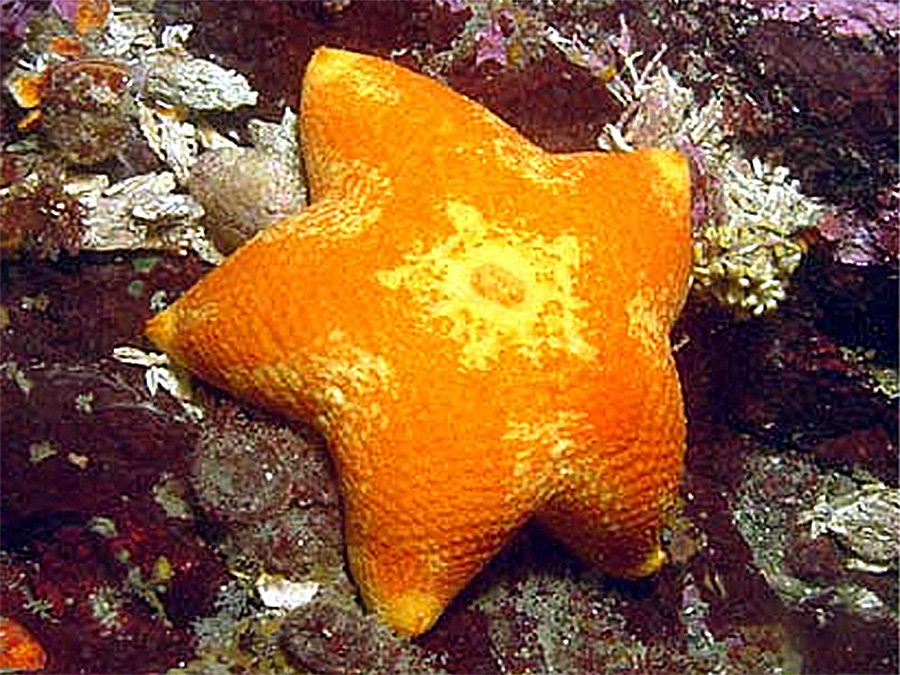Slime Star
Author: Zoe Nicholson
Photos courtesy of Andy Murch at www.elasmodiver.com
Common name: Slime Star, Cushion Sea Star
Scientific name: Pteraster tesselatus
Size range: up to 25 cm (10 inches) in diameter.
Identifying features: The slime star has a rounded pentagonal shape with a rigid and bumpy texture; they are very thick and resemble a pentagonal pincushion. Unlike many sea stars the normally whitish madreporite is hidden below a thick, fleshy, soft surface of tissue. They contain a raised pore in the soft tissue on their surface and can squirt out large amounts of sea water while they are respiring. On the bottom they have rows of suction cups (tube feet) simlar to other sea stars. The stars can be red, pink, pale orange or purple. The young ones are usually green- brown.

Habitat: These sea stars can be found in the Pacific and Atlantic oceans, ranging from upper-Canada to Central America. They mostly inhabit rocky areas and can be found as deep as 950m (3,120 ft). Young ones tend to be found in dense meadows of grasses or very rocky, uneven areas for protection.
Food: Cushion stars are omnivores. They eat a variety of things from algae, diatoms, small detritus particles to clams and oysters, sea urchins, sponge tissue, crab larvae and other small organisms. In general, capture its food, the sea star will use their arms to force the prey close, then push their stomachs out the mouth and engulf the prey. The mouth is located on the bottom in the center and each arm contains 2 pyloric caeca tubes which branch from the stomach. These tubes secrete digestive juices and absorb the nutrients. The food then passes into the very small, short intestines which then pass through the anus.
Predators: The slime star’s main predators are generally larger sea stars. It has an unusual defense mechanism, however. If attacked or disturbed this species of sea star releases copious amounts of slime that is toxic to other animals. For this reason care needs to be taken if it is housed in an aquarium.
Currently the biggest concern for sea stars is the environment. Throughout their habitats, they are being threatened by global warming and ocean acidification. Acidification is caused by the increase of CO2 in the atmosphere, which raises the pH in the ocean.
Respiration in sea stars occurs directly from water, through the papillae on their upper surface as well as through their tube feet. Due to the unique water-vascular system of sea stars they are very vulnerable to water pollution and ocean acidification; they don’t have the ability to filter out the waters contaminants.
Life Cycle: Most Sea Stars do have a specific sex, male or female, which is not externally apparent; however some species can be hermaphrodites. Fertilization is usually external. To increase the chances of their eggs being fertilized, starfish may synchronize their spawning, forming in a group or forming pairs. This is called pseudo-copulation. Usually, the male climbs onto the female, placing his arms between hers, and releases sperm into the water. This stimulates her to release her eggs. Starfish may use environmental signals to time the spawning, and chemical signals to indicate their readiness to each other. When the gametes meet they form together the resulting embryos and larvae live as part of plankton.
In certain species the females brood their eggs either by enveloping them or by holding them in specialized structures. The developing young are called “lecithotrophic” because they get their nutrition from the yolk inside the structure, instead of planktotrophic feeding larvae. Brooding is especially common in polar and deep-sea Sea Stars that live in environments less favorable for larval development.
In the slime star the female releases eggs into the water in the summer. The male releases sperm into the water which fertilizes the eggs. They pass through a number of planktonic stages before settling on the bottom of the ocean.
References:
BOOKS:
Lambert, P (2000). Sea Stars of British Columbia, Southeast Alaska and Puget Sound. Royal British
Lamb, A and Hanby, B (2005). Marine Life of the Pacific Northwest. Madeira Park, BC:Harbour Publishing
Columbia Museum, Victoria BC: UBC Press
Pechenik, J (2005). Biology of the Invertebrates: fifth edition. New York, NY: The Mcgraw-Hill Companies
ONLINE CITATIONS:
Boyd, S (2012). Cushion Star (Pteraster tesselatus.). Cushion Star. Retrieved January 16, 2013 from
http://www.boydski.com/diving/photos/seastars/cushion_star.htm
Shapiro, L. Facts About Cushion Sea Star. Cushion Sea Star. Retrieved January 14, 2013 from http://eol.org/pages/598571/details
Hollanders, S and To,I. Sea Stars. A student web page designed by Sheila Hollanders and Iona To. Retrieved January 17, 2013 fromhttp://oceanlink.island.net/biodiversity/seastars/seastars.html

